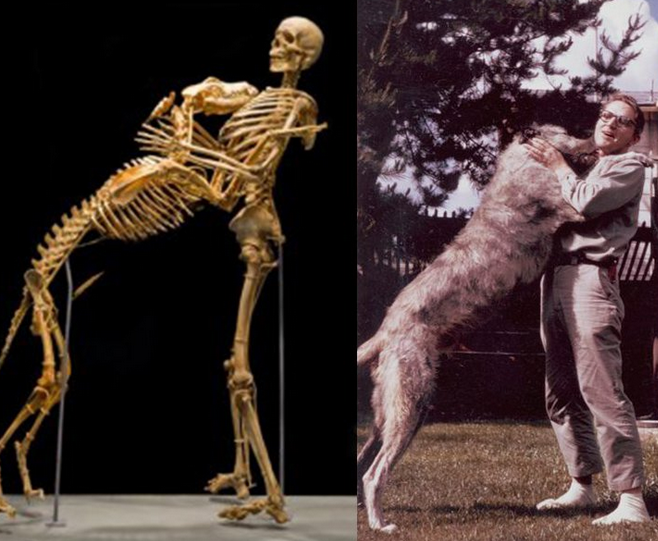
According to Smithsonian, Grover Krantz dedicated his body to science along with his beloved Irish wolfhound Clyde.
He wanted their bond to be remembered and their skeletons to aid forensics research. Archaeologist Mary Leakey's Dalmatians followed her to remote field sites where they would alert the team to dangerous wild predators. In addition to being faithful companions to scientists, dogs have participated in centuries of scientific discoveries and innovations. Involving dogs in some forms of science remains an ethical quandary because canines are intelligent, passionate beings. However, scientists still use them in biomedical and disease research and pharmaceutical toxicity studies for many reasons, including because dogs' physiology is closer to ours than rats'. Dogs working in science today also identify invasive species, aid in wildlife conservation and even help sniff out early signs of COVID-19 illness. As the number of duties for dogs in science continues to grow, it's worth looking back at crucial canine contributions to the field. https://www.si.edu/ We know a few dog owners who have probably considered the same thing.
Robot
The caves at Lascaux in southwestern France are famous for containing some of the world's most detailed and well-preserved examples of prehistoric art. More than 600 paintings created by generations of early humans line the cave walls. But if it wasn't for a white mutt named "Robot" who, by some accounts, discovered the caves in 1940, we may not have known about the art until many years later. Marcel Ravidat, an 18-year-old mechanic's apprentice, was walking with Robot when the dog slipped down a foxhole. When Ravidat followed Robot's muffled barks, he recovered more than just the dog—Robot had led him to one of the most significant archaeological finds of the 20th century.
Laika
A stray rescued from the streets of Moscow, Laika became the first dog to orbit the earth in 1957. Between 1951 and 1952, the Soviets began sending pairs of dogs into space, starting with Dezik and Tsygan. Nine dogs were sent on these early missions, with four fatalities. By the time Sputnik 2 launched with Laika aboard, astrophysicists had figured out how to get the canine astronaut into earth's orbit but not how to get her back from space. Once in orbit, Laika survived and circled for a little more than an hour and a half before sadly perishing when the temperatures inside the craft rose too high. Laika would have died on re-entry if the capsule's heat shield had not broken. While some protested the decision to send Laika into orbit knowing she would die, others defended the knowledge gained in showing animals could live in space.
Strelka and Belka
In August 1960, the Soviet Union launched the Sputnik 5 capsule into space. Along with mice, rats, and a rabbit, two dogs became the first living creatures to go into orbit and return to earth safely. These missions and other animal astronauts paved the way for human-crewed spaceflight. Less than a year after Strelka and Belka's successful voyage, the Soviets sent the human Yuri Gagarin into space. The canine pair went on to live entire dog lives and even had descendants.
Marjorie
Before the mid-1920s, a diabetes diagnosis was considered a death sentence. In 1921, however, Canadian researcher Frederick Banting and medical student Charles Best discovered insulin, which would save millions of human lives. The discovery would not have been possible without the sacrifice of several dogs with their pancreas removed, essentially causing clinical diabetes. Banting and Best with pancreatic extracts, then treated the animals. Marjorie was the most successful patient; she survived for more than two months with daily injections.
Togo and Balto
In 1925, diphtheria, an airborne respiratory disease that children are especially vulnerable to, swept through the remote Alaskan mining town of Nome. Since no vaccine was available then, an "antitoxin" serum was used to treat the disease. But getting it to Nome was a challenge. The nearest supply was in Anchorage, and trains could only bring it to within roughly 700 miles of Nome. More than 100 Siberian husky sled dogs, including Togo and Balto, were recruited to transport the serum. Togo ran double the distance of any dog in the relay and through the most dangerous regions, while Balto finished the last 55-mile stretch, delivering the serum safely to the families in Nome.
Trouve
Alexander Graham Bell's terrier helped the inventor with his early work. Bell's father, who worked with deaf populations, encouraged his son to develop a "speaking machine"—advice Bell enacted by manipulating his dog's bark to sound like a human voice. The younger Bell adjusted his dog's jowls as Trouve growled to train him to utter what sounded like the phrase, "How are you, Grandmama?" Bell became an expert in speech and hearing and ultimately became most famous for his invention of the telephone.
Chaser
In studying human brain evolution, many researchers look to humans' unique capability to use a complex language system for clues about our origins. But the more we learn about dogs, the more we realize that they, too, may have some hints. Chaser the Border Collie, who died in 2019 at age 15, famously learned to identify 1,022 proper nouns over her lifetime—giving her the most extensively tested word memory of any non-human animal. Her understanding of language and behavioral concepts provided insight into language acquisition, long-term memory, and the cognitive abilities of animals.